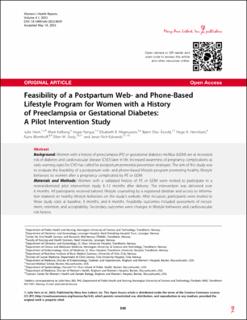| dc.contributor.author | Horn, Julie | |
| dc.contributor.author | Kolberg, Marit | |
| dc.contributor.author | Rangul, Vegar | |
| dc.contributor.author | Magnussen, Elisabeth Balstad | |
| dc.contributor.author | Åsvold, Bjørn Olav | |
| dc.contributor.author | Henriksen, Hege Berg | |
| dc.contributor.author | Blomhoff, Rune | |
| dc.contributor.author | Seely, Ellen | |
| dc.contributor.author | Rich-Edwards, Janet | |
| dc.date.accessioned | 2023-11-01T08:07:01Z | |
| dc.date.available | 2023-11-01T08:07:01Z | |
| dc.date.created | 2023-08-08T09:34:41Z | |
| dc.date.issued | 2023 | |
| dc.identifier.citation | Women's Health Reports. 2023, 4 (1), 345-357. | en_US |
| dc.identifier.issn | 2688-4844 | |
| dc.identifier.uri | https://hdl.handle.net/11250/3099902 | |
| dc.description.abstract | Background: Women with a history of preeclampsia (PE) or gestational diabetes mellitus (GDM) are at increased risk of diabetes and cardiovascular disease (CVD) later in life. Increased awareness of pregnancy complications as early warning signs for CVD has called for postpartum primordial prevention strategies. The aim of this study was to evaluate the feasibility of a postpartum web- and phone-based lifestyle program promoting healthy lifestyle behaviors to women after a pregnancy complicated by PE or GDM.
Materials and Methods: Women with a validated history of PE or GDM were invited to participate in a nonrandomized pilot intervention study 3–12 months after delivery. The intervention was delivered over 6 months. All participants received tailored lifestyle counseling by a registered dietitian and access to information material on healthy lifestyle behaviors on the study's website. After inclusion, participants were invited to three study visits at baseline, 3 months, and 6 months. Feasibility outcomes included assessment of recruitment, retention, and acceptability. Secondary outcomes were changes in lifestyle behaviors and cardiovascular risk factors.
Results: Of the 207 women invited, 44 were enrolled in the feasibility study and 40 women completed the intervention, corresponding to a recruitment rate of 21% and a retention rate of 91%. At the 3-month study visit, 94.6% of participants reported they had used the website. A total of 41.7% of the participants reported that they had achieved their personal goals during the intervention period.
Conclusions: This study suggested the feasibility and potential acceptability of a web- and phone-based lifestyle intervention for mothers with recent PE or GDM. | en_US |
| dc.language.iso | eng | en_US |
| dc.publisher | Mary Ann Liebert | en_US |
| dc.rights | Navngivelse 4.0 Internasjonal | * |
| dc.rights.uri | http://creativecommons.org/licenses/by/4.0/deed.no | * |
| dc.title | Feasibility of a Postpartum Web- and Phone-Based Lifestyle Program for Women with a History of Preeclampsia or Gestational Diabetes: A Pilot Intervention Study | en_US |
| dc.title.alternative | Feasibility of a Postpartum Web- and Phone-Based Lifestyle Program for Women with a History of Preeclampsia or Gestational Diabetes: A Pilot Intervention Study | en_US |
| dc.type | Peer reviewed | en_US |
| dc.type | Journal article | en_US |
| dc.description.version | publishedVersion | en_US |
| dc.source.pagenumber | 345-357 | en_US |
| dc.source.volume | 4 | en_US |
| dc.source.journal | Women's Health Reports | en_US |
| dc.source.issue | 1 | en_US |
| dc.identifier.doi | 10.1089/whr.2023.0039 | |
| dc.identifier.cristin | 2165515 | |
| cristin.ispublished | true | |
| cristin.fulltext | original | |
| cristin.qualitycode | 1 | |

